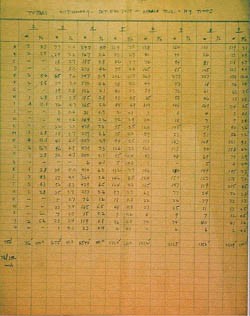A Game of Letters
Born on April 13, 1899: Alfred Mosher Butts, inventor of Scrabble®.

Have you ever wondered how the values and letter quantities were determined? Alfred Mosher Butts, who invented the game in 1938 as Criss-Cross Words, spent a great deal of time analyzing text samples during the development of the tile set. Attempting to pinpoint how common each of the 26 letters in the alphabet is in the English language, Butts manually tracked through the distribution of individual letters in text from sources like the New York Times. Based on his letter-frequency assessment, Butts established the breakdown of letters included in the set of 100 tiles and developed the corresponding point value distribution used in both Scrabble® and an earlier version of the game, Lexiko, both of which used the same point-based tile sets.
Making Connections
Butts' assessment of the English language was driven by his desire to create a challenging word-based game. But similar studies are carried out by scientists and scholars to analyze samples of writing, determine authorship and historical accuracy, and pinpoint other linguistic, lexicographic, and etymological trends. Students curious about lexicography, or even the newer discipline of stylometry, defined as "the science of measuring literary style," can conduct their own analyses of literary samples—either by hand, as Butts did, or using a variety of computer-based tools, programs, and algorithms. The Computer Sleuth: Identification by Text Analysis project from the Computer Science area lets students dive into this word-worthy area of research.
Categories:
You Might Also Enjoy These Related Posts:
- Plastics and Earth Day - Science Projects
- Arduino Science Projects and Physical Computing
- 10+ Robotics Projects with the BlueBot Kit
- 5 STEM Activities with Marshmallow Peeps
- March Madness Basketball Science Projects: Sports Science Experiments
- Women in STEM! More than 60 Scientists and Engineers for Women's History Month
- Explore Artificial Intelligence and Machine Learning with Student AI Projects
- 10 Reasons to Do the Rubber Band Car Engineering Challenge









